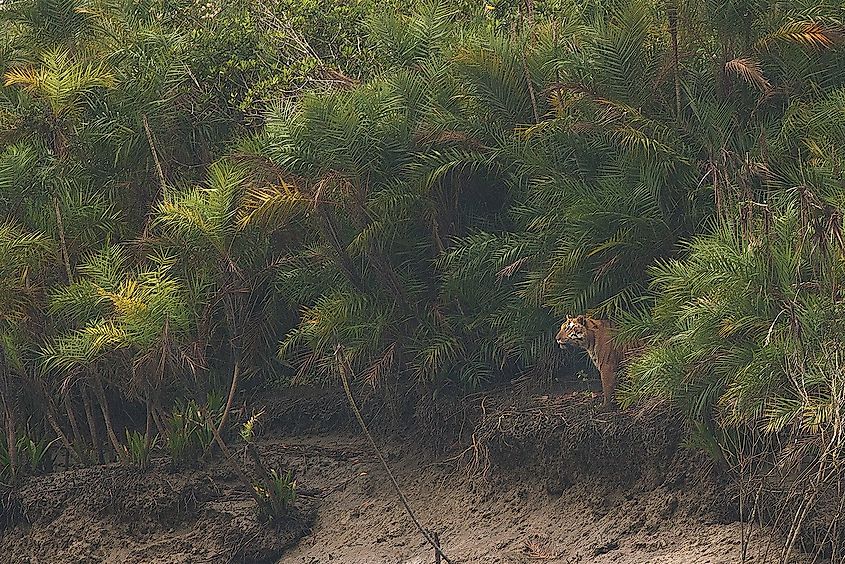Decoding The Mysterious Mangrove Tigers Of The Sundarbans

“Sitting there trying to keep alert in the still, hot air, I was aware of something nearby. I looked out on my camera angle of vision but that area was empty. I did not know why I felt like that and just to make sure, I gently lifted the netting to my left covering a small window. I saw a striped tail and the back legs of a tiger behind the tree no more than six feet away. I froze. It was perfectly feasible for it to jump straight on to the platform although my hide occupied most of the space. The tail was swishing and judging by the posture I guess that it was trying to work out where I was. I very slowly picked up the starting pistol and held it ready but eventually, I felt the tension go and with it the tiger, melting back into the forest." - Mike Herd
Many would say that wildlife cameraman and writer Mike Herd is a rare lucky individual who managed to escape the vicious jaws of the "man-eating tigers of the Sundarbans" while filming these tigers in their home turf in Bangladesh. Yes, that is the title the world has generously granted to these swamp tigers, the only tiger population known to reside in the unforgiving environment of a mangrove forest. Through decades, innumerable documentaries, films, books, and articles have been dedicated to portraying the Sundarbans tigers as "man-eaters." But are they truly deserving of this title? Do these tigers actively hunt humans as prey?
In this article, we try to answer these questions and explore the lives and true nature of these extraordinary tigers with the help of science, wildlife experts, and the rare few who are familiar with them. We also attempt to understand how these magnificent predators are braving the tide of changing times in the 21st-century world to survive in an environment that is hostile to most other living beings.
The Unique Address Of The Swamp Tigers

The "beautiful forests" or the Sundarbans, home to the swamp tigers, wears a crown of many jewels. Among them, the fact that it is the world's largest contiguous and most diverse mangrove forest and the only one of its kind to host a tiger population sparkle the most. Around 10,200 sq km of mangrove forests constituting the Sundarbans cover a large part of the deltaic region (about 40,000 sq. km in size) formed by the Ganga, Brahmaputra, and Meghna rivers as they drain into the Bay of Bengal. Approximately 4,200 sq. km of this mangrove forest or roughly 40% of the area lies within Indian territory (in the Indian state of West Bengal) and the rest is in neighboring Bangladesh. A large part of this mangrove forest is protected by law in both India and Bangladesh to secure the habitat for the region’s unique flora and fauna. UNESCO has also recognized the Sundarbans National Park of India and The Sundarbans of Bangladesh as World Heritage Sites (in 1987 and 1997 respectively).

The unusual landscape of the Sundarbans ecoregion features a dense network of mudflats, tidal channels, and creeks separating islands large and small. While some of these islands host human settlements, others have dense mangrove forests harboring the region's rich wildlife. Plants growing in the loose muddy alluvial soils are subjected to tidal action twice a day. They are specially adapted with features like stilt roots for support, pneumatophores for respiration, viviparous germination, succulent leaves, etc. The sundri tree (Heritiera fomes), growing here give the Sundarbans its name. There is also incredible faunal diversity in the Sundarbans including both aquatic and terrestrial species. The waters here are famous for their estuarine crocodiles, dolphins, sharks, water monitor lizards, etc. Notable animal species found on land include the fishing cat, leopard cat, rhesus macaque, wild pig, chital or spotted deer, giant fruit bats or flying foxes, and others. Many species of venomous snakes including the king cobra and the banded krait populate the islands. Incredible avian diversity of over 170 bird species is also seen here. What is more incredible is that all this wildlife is surrounded by human settlements with millions of people and a very high population density of about 1,000 persons per sq. km in the Indian Sundarbans region. The Bangladeshi section of the ecoregion also supports a large and rapidly growing human population.


But towering above all, creating an environment of awe, and earning global fame for the ecoregion, is the apex predator of the Sundarbans, the majestic Royal Bengal Tiger.
According to the most recent estimation of tiger numbers in the Indian Sundarbans by the West Bengal Forest Department, the tiger count is 96, exhibiting a rise from 88 in 2018-19. Bangladesh, however, scores higher with a tiger number of 114 in its Sundarbans forests as per the 2019 estimates by the region's Forest Department. But mere numbers do not always tell the entire story. When the tiger density is compared (as per a 2018 report), the Indian Sundarbans forests with a much smaller tiger-occupied area (1,841 sq. km) leads the way with 4 tigers per 100 sq. km, almost twice that of its neighbor, Bangladesh (2.17 tigers per 100 sq. km) with a tiger-occupied area of 4,832 sq. km.
Shaped By Nature, Born To Fight

Although the Sundarbans is an extremely productive ecosystem, terrestrial species living here including the tiger face constant challenges from a lack of freshwater and the difficult swampy terrain. Interestingly, nature has shaped these tigers by lending them unique traits not seen in tigers elsewhere so that they can thrive in their ruthless habitat. As a result, they do populate the mangrove swamps of the Sundarbans in significant numbers as mentioned above.
However, despite their notable presence, they are regarded as the world's most secretive tiger population as only a rare few humans have managed to enter the real realm of the swamp tigers to study them in detail. Most have left with only a fleeting glimpse of these majestic predators along the banks of the waterways. The difficult work environment in the swampy lands, the absence of trails and roads, the fear of tiger attacks, and the need for specialized survey methodologies impede many from taking up the challenge to conduct their research in the Sundarbans. Hence, there is still a paucity of reliable data and scientific research on this tiger population. However, there is no debate over the fact that these tigers stand out in more ways than one.
“The Sundarbans is a unique tiger habitat that is swampy, extremely humid, constantly under the influence of tides, has no large-bodied mammalian prey and lacks freshwater sources apart from some temporary pools during monsoon. These features have chiseled the characters that make Sundarbans tigers different from all other Royal Bengal tiger populations. Its small, stocky, and muscular frame; coarse and short coat and deep reddish-brown coloration are all adaptations to survive in this hostile habitat. Witnessing a tiger swim deceptively fast across a brackish-water channel, against a rapidly receding tide, is a sight to behold. Seeing it emerge from the water and move with consummate ease through knee-deep slush, leaving behind a trail of deep pugmarks, transports you back in time- to the era of dinosaurs. I have always been in awe of tigers, but seeing one in this mythical, mangrove-laden habitat increased my respect for these hunters exponentially" said Dr. Anish Andheria, India’s leading wildlife conservationist and President, Wildlife Conservation Trust (WCT), India. WCT works on the conservation of tiger and other wildlife in and around 160 protected areas in 23 Indian states covering 82% of India’s 50 tiger reserves.

Given the striking uniqueness of their habitat and the specialized adaptations of these tigers, for a while, it was thought that they could belong to a separate tiger subspecies, distinct from the Bengal tiger subspecies or Panthera tigris tigris found in other parts of the Indian subcontinent.
Studies like the one led by US scientist Adam Barlow in 2009 made a strong case for this possibility. It observed that the Sundarbans tiger is morphologically distinct from other tiger populations (including Bengal tigers in other parts of their range) in terms of body and skull size. The researchers suggested that these differences were "substantial enough to highlight the Sundarbans tigers as potentially distinct from other groups" and the smaller prey size of these tigers could be responsible for these variations. However, they also mentioned that due to the small sample size (3 female and 2 male Sundarbans tigers) used to conduct the study, all inferences should be regarded as tentative.
So, what does smaller prey size for these tigers mean?
“The diet of the Sundarbans tiger is quite different from that of tiger populations elsewhere,” said Lt. Col. Shakti Ranjan Banerjee (Retd), Honorary Director, Wildlife Protection Society of India and former West Bengal State Director of WWF-India.
"In other parts of India, Bengal tigers are known to take down large ungulates like sambar, gaur, and other big mammals in addition to smaller prey. However, in the Sundarbans, such large-sized mammals are absent. Instead, the tiger here feeds on a wide variety of terrestrial and aquatic species like spotted deer, wild pigs, rhesus macaques, birds, otters, fish, water monitors, crabs, turtles, etc. I remember a time when a captured Sundarbans tiger was offered a crab in the Alipur Zoo in Kolkata. It deftly removed the shell of the crab and consumed the meat. I also witnessed an unfortunate incident where a Sundarbans tiger was discovered dead. Post mortem analysis of its body revealed that it had eaten two highly venomous snakes, a King cobra, and a monocled cobra. Also, another very important aspect of these tigers is that it drinks saline water,” informed Lt. Col. Banerjee.

“The Sundarbans tiger also hunts by the tides and in the water relishing on the wide variety of aquatic prey that its unique habitat has to offer. It has mastered the art of swimming and despite raging currents and the presence of crocodiles and sharks in the water, it successfully navigates its way from an island to another in search of prey and mate,” he continued.
"Life is a constant struggle for these tigers," said Anil Mistry, Founder of the “Bali Nature and Wildlife Conservation Society”, an NGO working in the Indian section of the Sundarbans to protect the mangrove ecosystem. He also serves the role of the principal field officer of the Wildlife Protection Society of India (WPSI). With his active role in numerous tiger rescue operations in the Sundarbans, Mistry is one of those few fortunate ones to know the swamp tigers up close and personal. Today, he is one of the strongest voices for these tigers in the Sundarbans region.
"Saline waters, muddy terrain, and dense jungles comprise their environment. For every hunt, the tiger has to put in a lot of effort. Running and navigating its way through the sharp-edged pneumatophores and the deep muddy ground is always challenging. Sometimes, the tiger also needs to fend off crocodiles and sharks in the water while swimming. So you can well understand that the Sundarbans tigers are a tough lot," Mistry painted the picture of the daily struggles of his favorite tigers.
Other than a more tedious life, there are several other factors that also distinguish this tiger population from tigers in other habitats.
According to a 2015 scientific study led by Naha and Jhala that studied three male and three female Sundarbans tigers that were GPS-Satellite and VHF radio-collared, the average home range for male Sundarbans tiger was 110 sq. km and that for resident females was 56.4 sq. km. The values may be compared to the home range of another Bengal tiger population in mainland India’s Pench National Park. The Sundarbans tigers also swim an average of around five water channels with a mean width of 54 m per day. But they generally avoid crossing channels that are over 400 m wide. While tigers elsewhere are proficient swimmers as well and are known to spend significant time cooling themselves immersed in water bodies, the relationship between swamp tigers and water is at a completely different level. They are said to lead a nearly amphibious life. The study also found the Sundarbans tigers to be most active between 05:00 and 10:00 hours.

Given the traits that differentiate Sundarbans tigers from other populations of Bengal tigers, as well as other subspecies of tigers, questions were raised whether these tigers were genetically different enough to be classified to be a separate subspecies.
In 2015, a scientific study explored the question. From genetic experiments, the researchers concluded that the Sundarbans tiger was not a separate subspecies but the most divergent group of Royal Bengal tigers. However, they also suggested that being "ecologically non-exchangeable with other tiger populations", these tigers deserved treatment as a separate ESU or evolutionarily significant unit.
Man-eating Decoded

It is not just the above-mentioned differences that make the Sundarbans tigers stand out. "Man-eaters of the Sundarbans" is the tag that brings these tigers to the spotlight and the eyes of the globe on them.
But before going into further discussion, let us first look at the definition of “man-eating tiger.” What we find is that “man-eating tiger” is a colloquial term. In the Indian subcontinent, it was popularised during the British rule and remained as a part of the colonial legacy in the countries of the subcontinent. After coming into power, the British launched a massive attack on the region’s tiger population intending to exterminate the species. Tigers were then often tagged as “man-eaters” and rewards were given to those who hunted them down.
Below is mentioned what the term "man-eaters" implied during the colonial era in India:
“The term Man-eater is applied to those Tigers, which, deserting their usual haunts in the jungle, frequent the neighborhood of Villages, and prey chiefly on men. They are almost invariably found to be old animals, and generally females. They are usually very cunning and cowardly”- Capt. Walter Campbell, "The Old Forest Ranger; or, Wild Sports of India," 1842.

"Given the negative and misleading connotation associated with the term man-eating tigers, its usage has rightly been removed from policy papers in India," said Dr. Andheria.
“The word man-eater wrongly over-emphasizes the man-killing habit of the tigers. In more than two decades of conservation work that I have carried out, it is clear that baring very few individuals, tigers tend to stay clear of humans. Of the human deaths that have occurred due to tigers, an overwhelmingly high proportion can be attributed to an accident at best. Calling such accidents as acts of a man-eater creates unprecedented fear in the minds of local communities, who then start over-reacting to every single interaction with tigers. Media too has a big role to play in sensationalizing tiger attacks on humans. If tigers were such bloodthirsty beasts as they are oft portrayed, India alone should have lost thousands of humans to tiger attack every year as nearly 3/4th of all tigers have access to humans on a daily basis,” he adds.
In fact, on November 11, 2019, National Tiger Conservation Authority (NTCA), India's highest body governing tiger conservation in the country, issued a historic declaration. In their revised guidelines/SOP, NTCA abolished the usage of the term "man-eaters." It mentioned that big cats attacking and feeding on humans would now be tagged as "dangerous to human life". This decision by the NTCA was largely appreciated by conservationists and wildlife veterinarians across the country. It was a big move given that India hosts over 70% of the global wild tiger population.
So, given the absence of a concrete definition and policies discouraging the use of the term “man-eater,” it will also be avoided as the article proceeds further.
Are Swamp Tigers Prone To Kill Humans?
Although we are not using the term “man-eaters” there is a need to investigate the reason why the Sundarbans tiger population has been associated with human-killing incidents more than any other tiger population in the world. It is often said that “there is no smoke without fire” - is the saying true for these tigers as well? For that let us take a look at some history, published data, and the views of experts.
"From what I have seen since childhood, our village folk including my father and grandfather would cut down the forests to expand our villages. They would enter forests unabated to collect wood and other forest produce and also hunt animals including tigers. There was no barrier between humans and wildlife in those days - around four decades back. No fencing or anything between the forest and human settlements existed. Hence, conflicts were common. I remember when I was in class 8, and a tiger entered our village. For seven long days, it was chased around until it was eventually gunned down. Again, humans entering the forest also got killed in tiger attacks," recounted Mr. Mistry who was born and brought up in the Bali Island of the Sundarbans very close to prime tiger territory in the region.
The case was true not just for Mr. Mistry’s village, but, according to accounts, most other villages in proximity to the tiger habitat in the Sundarbans ecoregion. For decades, villagers from these settlements have trespassed into tiger territory, some with legal permits and others illegally, to collect a range of forest produce like honey, fish, crabs, wood, and golpatta for their livelihood. In some cases, tigers have also ventured into areas of human settlement. Human-tiger interactions resulting from such movements have often had unpleasant results, both for the tigers and the humans, as mentioned by Mr. Mistry.

Such negative consequences are, however, possible in any tiger habitat exposed to high-frequency human-tiger interactions. But why then the Sundarbans tigers are marked as human killers and not tiger populations elsewhere? Are these tigers especially aggressive or predisposed to treat humans as prey? Let us take a look at historical and more recent data:
Old records (during the colonial era when tigers were hunted extensively as "man-eaters") suggest that the Sundarbans tigers killed and consumed 4,218 people in just six years in the 1860s (or an average of 703 human deaths annually).
From the 1950s to 1970s (after the end of colonial rule) these tigers were held responsible for 800 human deaths in the entire Sundarbans region (an average of 40 human deaths annually).
Coming to more recent data, estimates (the early 1990s) suggest that an average of around 36 people are killed annually on the Indian side of the Sundarbans while 22 people are killed annually by tigers on the Bangladesh side (based on data collected between 1975 and 1999).
According to WWF India, 666 people succumbed to injuries inflicted by tiger attacks in the Indian Sundarbans region between 1985 and 2008 (or an average of around 29 human deaths annually). During this same time, 279 incidents of tigers entering the fringe villages also occurred.
In the Bangladesh Sundarbans region, 519 men living in 50 villages in a single district were killed in tiger attacks between 2001 and 2011 (or an average of 50 human deaths annually) as per Ledars Bangladesh charity.
Coming closer in time, according to official records, 52 humans deaths due to tiger attacks were registered in the Sundarbans Tiger Reserve of India from 2010 to 2017 (around 7.4 human deaths annually).
As per another government report, 0, 15, 2, and 1 human deaths due to tiger attacks were reported in the West Bengal state of India in 2015, 2016, 2017, and 2018 respectively (Important to note: 1. The entire population of tigers in the state is concentrated in the Sundarbans region 2. The figures represent official estimates and deaths due to tiger attacks resulting from illegal entry into the Sundarbans forest is not included in this record).
The above data, however, do not yield any information as to the human-killing nature of the Sundarbans tiger unless compared to that of tiger populations elsewhere and further analysis is needed on the same to conclude.
Now, coming to what experts and those who know these tigers have to say about the human-killing behavior of Sundarbans tigers or that of tigers in general:
"Unlike other tigers, those in the Sundarbans have a reputation for killing and eating people, although it is mainly restricted to the western Sundarbans," said Dr. M. Monirul H. Khan, Professor of Zoology, Jahangirnagar University, Bangladesh, and a leading wildlife biologist with a strong background of research on wildlife in the Bangladesh Sundarbans.
"The stories of tigers hunting humans in the Sundarbans are not fully exaggerated because the few tigers that are known to hunt humans there are believed to do that deliberately. Hunting people is easier than hunting wild prey because people are less capable of detecting an approaching tiger than the wild prey species. In other tiger ranges, tigers hunting humans are rare and are usually either old or injured tigers. In the Sundarbans, however, both healthy and old tigers were found to treat humans as prey. Also, the actual total number of human deaths due to tiger attacks is higher than the official records, because the deaths of illegal intruders and deaths that take place later due to fatal injuries are often not recorded officially," continued Dr. Khan.

"Tigers are not predisposed to killing humans for food. On rare occasions, when there is an insufficiency of natural prey or the tiger is too old or injured to hunt wild prey, it might resort to attacking humans. On rare occasions, tigers that get repeatedly exposed to humans from a young age can lose the fear of them. They might also accidentally kill and eat a human. Such animals may start treating humans as prey. Such cases are possible in the Sundarbans where many people enter tiger territory on foot to collect forest produce. With large-bodied mammals being absent in the tiger's diet in the Sundarbans, humans can become a more convenient kill for a tiger in the region," said Dr. Andheria.
"As a species, tigers just want to get on with their lives and in my experience, generally try to keep away from people," claimed Mike Herd, the first person to film the Sundarbans tigers and the man behind the multiple award-winning wildlife documentary "Swamp Tigers."
"A tiger can actively hunt humans if it is old or too sick to catch wild prey. Sometimes a sleeping tiger will be woken by someone and simply react, then realizing how easy and tasty humans are could continue to form a career of eating people. In the Sundarbans, many people do not have permits to go into the forest but yet enter tiger territory, and they are more likely to meet tigers unwittingly. The number of people killed by tigers in the Sundarbans is probably conservative because of illicit poachers and fishers," Mr. Herd explained further.
“If human intrusion into tiger habitats is lowered, then deaths will automatically diminish. Most human killings in Sundarbans are recorded when humans enter restricted areas illegally. If people were to follow the rules, deaths could be minimized," said Lt. Col. Banerjee.
“It is not just tigers, but crocodiles and sharks also claim the lives of humans in the Sundarbans area," said Mr. Mistry. “But these hardly get noticed in a region where tigers are given all the attention, both positive and negative,” he said.

Thus, from the above information and accounts, it can be said that the Sundarbans tigers do prey on humans and the distinctiveness of their mangrove habitat including the availability of smaller prey and difficult terrain could attract them to hunt humans as food.
Over time, many theories like the drinking of saline water, exposure to human corpses washed away by cyclone-triggered floods, and the lack of fear of humans due to less hunting pressure have been suggested to explain the alleged human killing behavior of these tigers. None of these theories, however, have been proved by science to date.
The above discussion also raises some questions.
How many tigers in the Sundarbans region actively hunt humans? What is the total number of humans killed by tigers in the region (official figures plus the unreported data of those entering illegally)? If all the Sundarbans tigers (an estimated 114 + 96 = 210) were actively hunting humans as prey, then how many humans would be killed by these tigers? How many people are actually killed by the Sundarbans tigers and not by other predators like crocodiles and sharks?
In the absence of answers to these questions, does the marking of the Sundarbans tiger population as "man-eaters of the Sundarbans" become questionable?
Myriad Of Challenges In The 21st Century

So while the exploration of the true nature of the Sundarbans tiger continues, one cannot deny that they save millions of human lives. How? Dr. Andheria explained:
"Thank the mangrove forests of Sundarbans, which have been secured in the name of the tiger, for greatly reducing the negative impact of cyclones. Without tigers and these extensive forests, the Sundarban delta would have been overrun with human habitations. And..., these very habitations would have got irreversibly devastated by the wrath of cyclones like Amphan.
The tensile strength and profusion of trees tone down the influence of high-velocity winds. As a result, one sees a far greater number of uprooted trees in cities than in thick forests such as Sundarbans. Tigers have lived in these extreme ecosystems for thousands of years. Hostile weather conditions do adversely impact them and other wild species, but the impact is inversely proportional to the size of the forest. The larger the forest the faster is the recovery rate of animal populations and hence, even if some individuals may perish, the ones that survive will ensure that the population bounces back faster than one can imagine.
The mangrove forests of Sundarbans stretch over 10,000 sq.km. Their sheer size is their biggest advantage. Without the protection mechanism instituted by the government in the name of Project Tiger in 1973, these forests would have dwindled drastically. Consequently, cyclones would have caused an unparalleled loss of human life and property, in addition to the local extinction of many wild species including the tiger. Hope humans understand this fact and lay more emphasis not only on conserving these unique amphibious tigers but also securing their equally unique mangrove habitat."

Thus, given their immense importance as explained by Dr. Andheria, it is vital to ensure the survival of these tigers and their habitat into the future. The 21st century brings both good and bad news for these tigers. While improved management practices have helped mitigate negative human-tiger interactions to a great extent, more needs to be done in this direction. Other threats to these tigers are also growing as evident from what experts mentioned below:
"Human-killing incidents by tigers in the Sundarbans region of Bangladesh have been very low in recent years because the natural resource harvest from the Sundarbans has become limited and, to some extent, unpopular (due to the fall of market demands of many products). Also, in 2017, the protected area coverage was increased to just over 50% of the Bangladesh Sundarbans where the resource harvest is not allowed,” said Dr. Khan.
"Tigers, on the other hand, are threatened by direct killing due to poaching and retribution, prey depletion, habitat loss, and degradation. Little is known about tiger poaching, available information mostly comes from opportunistic arrests or seizures by the authorities. About two to three tigers are killed every year in the Bangladesh Sundarbans. Poachers kill tigers mainly through using poison-baits but shooting and snaring are also reported. In the villages around the Sundarbans, tigers are killed occasionally by angry villagers for retribution, because the tiger is perceived as a threat to villagers and their livestock when it strays into the village," he mentioned further.
Changes have also taken place on the Indian side as well, as explained by Mr. Mistry:
"A lot of positive changes have taken place in the Sundarbans area of India in recent times. Earlier, people used to kill tigers entering villages and also put the blame on the forest department. Now, they co-operate more due to greater awareness. Also, cases of tigers wandering into human settlements are extremely rare here now. Nylon fencing along the forest fringes have been a great help in ensuring that tigers do not exit the safety of their home. Along with this, the forest department and NGOs working in the region are striving to provide the people with alternative sources of livelihood to reduce the number of those entering the forest to earn a living, and risking their lives and the reputation of the tigers in the process," he said.
"While it is true that there are households here where they have lost their sole earning member to tigers, there are neighboring homes where people survive as they choose not to enter the forest to supplement their income. It is often greed and not need that makes people fall prey to tigers. But yes, people here are overall poor and hence, we are working on providing them with alternative but safe choices of earning extra income," he continued.

According to Ratul Saha, Landscape Coordinator, WWF-India Sundarbans Landscape, Wildlife and Habitats Division, another major threat is looming large over these mangrove tigers:
"The Sundarbans ecoregion is increasingly impacted by frequent cyclones, storm surges, climate change-induced sea-level rise, and reduced flow of freshwater into the mangrove ecosystem. Wild tigers living in the Sundarbans are known to be able to travel from island to island as they are good swimmers. However, with rising sea levels, their available habitat is likely to shrink, pushing wild tigers further inland. At the same time, rising sea surface temperatures over the Bay of Bengal and ocean acidification along the coast are expected to negatively impact the rich fisheries in the Sundarbans. Local communities in this region depend on fisheries as a primary source of nutrition and as a livelihood option. Such changes could lead to decreased livelihood options for the fisherfolk community and increase the vulnerability of the communities living there. Fisherfolk are now moving deeper into the mangroves for fishing and they often fall prey to wild tigers, thus, human-tiger negative interaction is also a challenge in Sundarbans," he said.
Securing The Life Of The Sundarbans Tiger

Given the growing threats to the mangrove tigers and their habitat, much needs to be done to secure their future and that of those dependent on the Sundarbans ecoregion for their survival including millions of humans. Here is what experts have to say about mitigation measures:
“To reduce the tiger-human conflicts, several measures were implemented and were found effective, so these should be strengthened. Other than the Forest Department's improved patrolling, the Tiger Response Team formed by the local people helps the Forest Department to mitigate the conflict by driving the stray tiger from village to forest. People traditionally use fire-crackers to deter the tiger and fences to protect the residential areas. Working in groups, with at least some carrying a big stick, and keeping a domestic dog (which must be vaccinated, and leashed) with each team to warn the presence of the tiger might be a useful form of protection. An experiment of using packs of trained domestic dogs to deter the tiger from coming to the village was found to be effective. Moreover, public awareness and compensation programs are very useful to change the attitude of the local people,” mentioned Dr. Khan.
Mr. Saha from WWF-India enlists the following strategies to protect the Sundarbans tigers:
- Restoration of habitat - Per the protocol signed on 6 September 2011 between India and Bangladesh on the conservation of the Royal Bengal Tiger of the Sundarbans, there is a need for a comprehensive study to investigate habitat productivity given the climate vulnerabilities. The study will help identify hotspots that harbor higher diversity of mangrove plant species, which can grow under limited nutrient availability compared to other places. These hotspots will serve as an ideal site for a detailed investigation of the habitat productivity under the given vulnerability context. These hotspots will also act as source sites for transplantation of resilient mangroves to other parts of this landscape, expanding options for the restoration of severely impacted areas of this dynamic and fragile ecosystem.
- Coping with the issues arising due to climate change in the Sundarbans region. The general steps to be followed include: (1) identify natural, and human assets of interest, (2) determine vulnerabilities of and risks to these assets from climate change, (3) identify potential management action, (4) quantify the effectiveness value of management actions, (5) determine costs of management actions, and (6) determine an optimal set of management actions given costs and budget constraints.
- Effective and timely management of negative interaction between humans and wildlife through innovative and inclusive measures, including physical barriers and early warning systems.

"Nylon netting barriers at the forest-human settlement interface has been greatly effective in reducing negative interactions between tigers and people. Compensation is given for losses related to tiger attacks. The same can be extended to cover crocodile and shark attacks as well. This will reduce the false attribution of several human deaths because of these two species on tigers. Alternative livelihood options must be made available for the villagers inhabiting the Sundarbans to reduce dependence on forests. Further collaboration between India and Bangladesh must also be encouraged for holistic management of the entire Sundarbans ecoregion," said Dr. Andheria.
“Until a few decades ago, I was almost certain that the tigers of Sundarbans would withstand the onslaught of humans better than those in other parts of India and other tiger range countries. However, the impending threat of climate change and the resultant increase in the frequency of extreme weather events, coupled with sea-level rise, has negatively altered the fortune of this highly adaptive animal. Those very adaptations that have allowed the species to flourish in one of the most hostile habitats may now result in its downfall! Evolution is considered as a process that allows species to adapt to the ever-changing climatic conditions in nature. That, one species, called Homo sapiens, through its absolute disregard for nature’s ways, has altered the rhythm of this beautiful blue planet so much that even the most adaptive carnivore is being pushed to the brink, is absolutely heart-wrenching. The tiger of Sundarbans is the barometer for all terrestrial life forms that live along the interface between land and sea. Its fate is intricately connected with the fate of thousands of species and billions of human beings. Hope we know how to read it!”
World Atlas would like to exhibit gratitude to Dr. Anish Andheria for his expert advice and constant encouragement in writing this article.











